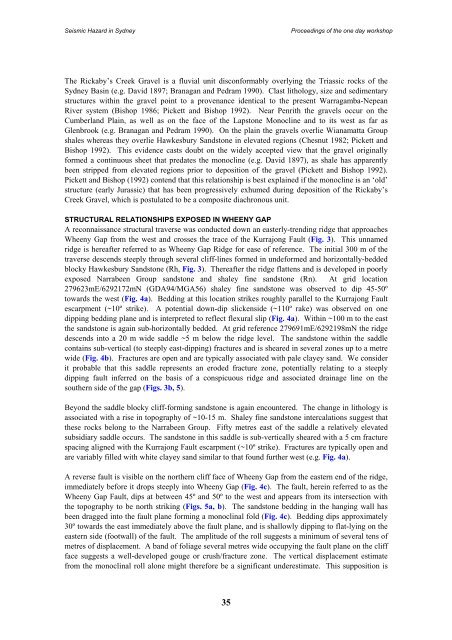Landslides in the Sydney Basin - Geoscience Australia
Landslides in the Sydney Basin - Geoscience Australia
Landslides in the Sydney Basin - Geoscience Australia
- No tags were found...
You also want an ePaper? Increase the reach of your titles
YUMPU automatically turns print PDFs into web optimized ePapers that Google loves.
Seismic Hazard <strong>in</strong> <strong>Sydney</strong>Proceed<strong>in</strong>gs of <strong>the</strong> one day workshopThe Rickaby’s Creek Gravel is a fluvial unit disconformably overly<strong>in</strong>g <strong>the</strong> Triassic rocks of <strong>the</strong><strong>Sydney</strong> Bas<strong>in</strong> (e.g. David 1897; Branagan and Pedram 1990). Clast lithology, size and sedimentarystructures with<strong>in</strong> <strong>the</strong> gravel po<strong>in</strong>t to a provenance identical to <strong>the</strong> present Warragamba-NepeanRiver system (Bishop 1986; Pickett and Bishop 1992). Near Penrith <strong>the</strong> gravels occur on <strong>the</strong>Cumberland Pla<strong>in</strong>, as well as on <strong>the</strong> face of <strong>the</strong> Lapstone Monocl<strong>in</strong>e and to its west as far asGlenbrook (e.g. Branagan and Pedram 1990). On <strong>the</strong> pla<strong>in</strong> <strong>the</strong> gravels overlie Wianamatta Groupshales whereas <strong>the</strong>y overlie Hawkesbury Sandstone <strong>in</strong> elevated regions (Chesnut 1982; Pickett andBishop 1992). This evidence casts doubt on <strong>the</strong> widely accepted view that <strong>the</strong> gravel orig<strong>in</strong>allyformed a cont<strong>in</strong>uous sheet that predates <strong>the</strong> monocl<strong>in</strong>e (e.g. David 1897), as shale has apparentlybeen stripped from elevated regions prior to deposition of <strong>the</strong> gravel (Pickett and Bishop 1992).Pickett and Bishop (1992) contend that this relationship is best expla<strong>in</strong>ed if <strong>the</strong> monocl<strong>in</strong>e is an ‘old’structure (early Jurassic) that has been progressively exhumed dur<strong>in</strong>g deposition of <strong>the</strong> Rickaby’sCreek Gravel, which is postulated to be a composite diachronous unit.STRUCTURAL RELATIONSHIPS EXPOSED IN WHEENY GAPA reconnaissance structural traverse was conducted down an easterly-trend<strong>in</strong>g ridge that approachesWheeny Gap from <strong>the</strong> west and crosses <strong>the</strong> trace of <strong>the</strong> Kurrajong Fault (Fig. 3). This unnamedridge is hereafter referred to as Wheeny Gap Ridge for ease of reference. The <strong>in</strong>itial 300 m of <strong>the</strong>traverse descends steeply through several cliff-l<strong>in</strong>es formed <strong>in</strong> undeformed and horizontally-beddedblocky Hawkesbury Sandstone (Rh, Fig. 3). Thereafter <strong>the</strong> ridge flattens and is developed <strong>in</strong> poorlyexposed Narrabeen Group sandstone and shaley f<strong>in</strong>e sandstone (Rn). At grid location279623mE/6292172mN (GDA94/MGA56) shaley f<strong>in</strong>e sandstone was observed to dip 45-50ºtowards <strong>the</strong> west (Fig. 4a). Bedd<strong>in</strong>g at this location strikes roughly parallel to <strong>the</strong> Kurrajong Faultescarpment (~10º strike). A potential down-dip slickenside (~110º rake) was observed on onedipp<strong>in</strong>g bedd<strong>in</strong>g plane and is <strong>in</strong>terpreted to reflect flexural slip (Fig. 4a). With<strong>in</strong> ~100 m to <strong>the</strong> east<strong>the</strong> sandstone is aga<strong>in</strong> sub-horizontally bedded. At grid reference 279691mE/6292198mN <strong>the</strong> ridgedescends <strong>in</strong>to a 20 m wide saddle ~5 m below <strong>the</strong> ridge level. The sandstone with<strong>in</strong> <strong>the</strong> saddleconta<strong>in</strong>s sub-vertical (to steeply east-dipp<strong>in</strong>g) fractures and is sheared <strong>in</strong> several zones up to a metrewide (Fig. 4b). Fractures are open and are typically associated with pale clayey sand. We considerit probable that this saddle represents an eroded fracture zone, potentially relat<strong>in</strong>g to a steeplydipp<strong>in</strong>g fault <strong>in</strong>ferred on <strong>the</strong> basis of a conspicuous ridge and associated dra<strong>in</strong>age l<strong>in</strong>e on <strong>the</strong>sou<strong>the</strong>rn side of <strong>the</strong> gap (Figs. 3b, 5).Beyond <strong>the</strong> saddle blocky cliff-form<strong>in</strong>g sandstone is aga<strong>in</strong> encountered. The change <strong>in</strong> lithology isassociated with a rise <strong>in</strong> topography of ~10-15 m. Shaley f<strong>in</strong>e sandstone <strong>in</strong>tercalations suggest that<strong>the</strong>se rocks belong to <strong>the</strong> Narrabeen Group. Fifty metres east of <strong>the</strong> saddle a relatively elevatedsubsidiary saddle occurs. The sandstone <strong>in</strong> this saddle is sub-vertically sheared with a 5 cm fracturespac<strong>in</strong>g aligned with <strong>the</strong> Kurrajong Fault escarpment (~10º strike). Fractures are typically open andare variably filled with white clayey sand similar to that found fur<strong>the</strong>r west (e.g. Fig. 4a).A reverse fault is visible on <strong>the</strong> nor<strong>the</strong>rn cliff face of Wheeny Gap from <strong>the</strong> eastern end of <strong>the</strong> ridge,immediately before it drops steeply <strong>in</strong>to Wheeny Gap (Fig. 4c). The fault, here<strong>in</strong> referred to as <strong>the</strong>Wheeny Gap Fault, dips at between 45º and 50º to <strong>the</strong> west and appears from its <strong>in</strong>tersection with<strong>the</strong> topography to be north strik<strong>in</strong>g (Figs. 5a, b). The sandstone bedd<strong>in</strong>g <strong>in</strong> <strong>the</strong> hang<strong>in</strong>g wall hasbeen dragged <strong>in</strong>to <strong>the</strong> fault plane form<strong>in</strong>g a monocl<strong>in</strong>al fold (Fig. 4c). Bedd<strong>in</strong>g dips approximately30º towards <strong>the</strong> east immediately above <strong>the</strong> fault plane, and is shallowly dipp<strong>in</strong>g to flat-ly<strong>in</strong>g on <strong>the</strong>eastern side (footwall) of <strong>the</strong> fault. The amplitude of <strong>the</strong> roll suggests a m<strong>in</strong>imum of several tens ofmetres of displacement. A band of foliage several metres wide occupy<strong>in</strong>g <strong>the</strong> fault plane on <strong>the</strong> cliffface suggests a well-developed gouge or crush/fracture zone. The vertical displacement estimatefrom <strong>the</strong> monocl<strong>in</strong>al roll alone might <strong>the</strong>refore be a significant underestimate. This supposition is35
















